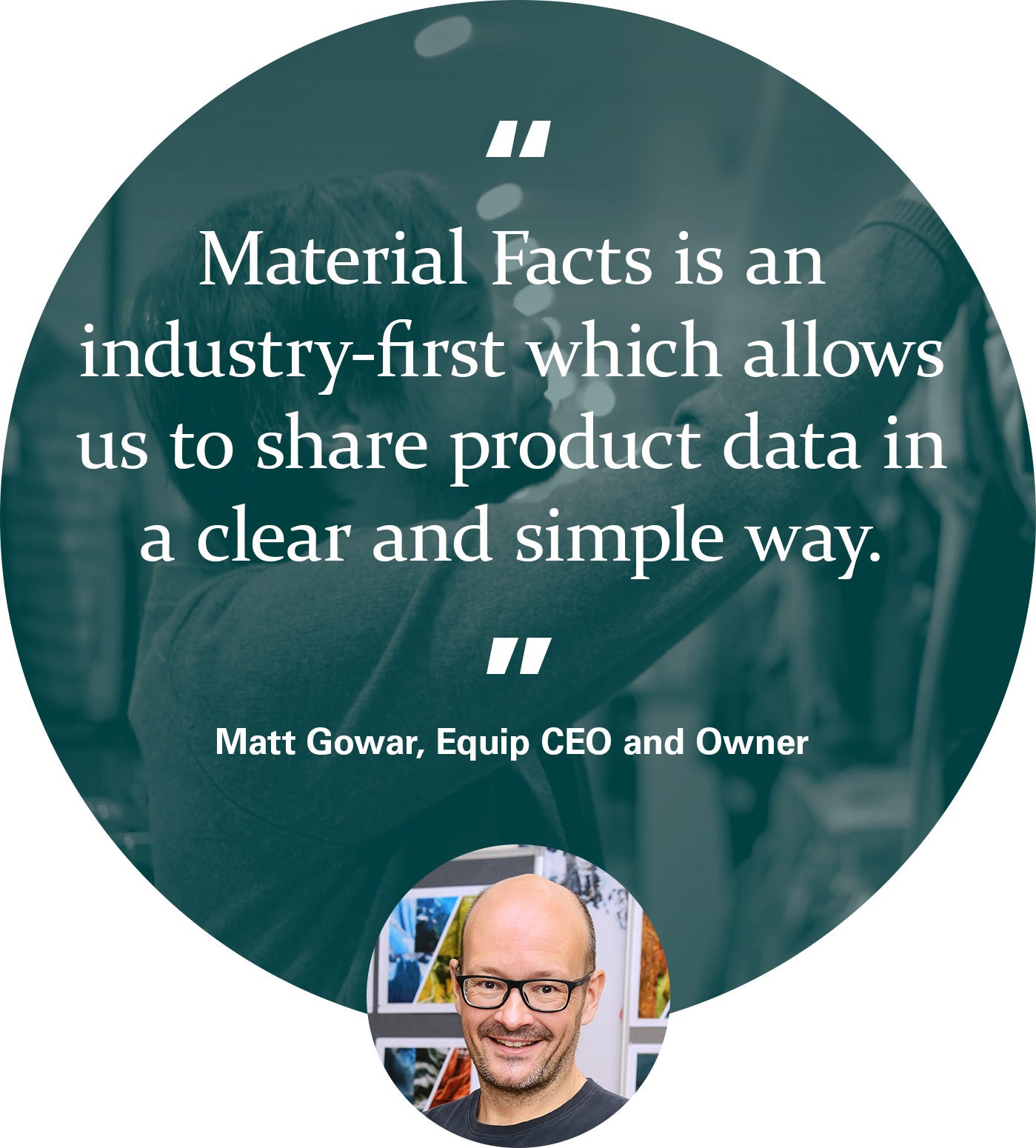Material Facts
Our simple solution to the complicated questions around sustainable clothing and equipment.
Sustainability.
It’s Complicated.
Sustainability.
It’s Complicated.
Sustainability.
It’s Complicated.
The outdoor industry has long been passionate about reducing our impact and preserving our mountain playground. But we recognise that sustainability claims about our products can be confusing.
We know that you expect more. That you want us to be clear about what’s in our products and where they’re made.






Why Material Facts?
Discover why we’re introducing Material Facts and hear our plans for it to evolve in the future.




What’s next for Material Facts?
What’s next for Material Facts?
We believe Material Facts is the way forward. But we know there’s always room for improvement. We might not have it right just yet, but we’re transparent and open to an industry-wide dialogue.
We’re working towards creating tables for our remaining gear and expanding the scope of the data included.
We see Material Facts as a solution for all sorts of brands, from footwear to equipment, and are challenging others to join us in sharing the same way.


What’s next for Material Facts?
What’s next for Material Facts?
We believe Material Facts is the way forward. But we know there’s always room for improvement. We might not have it right just yet, but we’re transparent and open to an industry-wide dialogue.
We’re working towards creating tables for our remaining gear and expanding the scope of the data included.
We see Material Facts as a solution for all sorts of brands, from footwear to equipment, and are challenging others to join us in sharing the same way.
What about Material Facts tables for older products?
What about Material Facts tables for older products?
We are always looking to improve our products, so sometimes their Material Facts data changes.
If you’re searching for a Material Facts table for an older version of a product, take a look in our archive.




What about Material Facts tables for older products?
What about Material Facts tables for older products?
We are always looking to improve our products, so sometimes their Material Facts data changes.
If you’re searching for a Material Facts table for an older version of a product, take a look in our archive.
Want to Know More?
Check out our Material Facts Q&A page to dive into the detail.
The Material Facts data has been calculated by component, by item and by weight. Each table has been manually checked by product and material experts and cross-checked with fabric and factory certificates. We rely on our partners across our supply chain to provide us with timely, accurate and up-to-date information. We have taken all reasonable steps to ensure accuracy. However, it is possible that inadvertent errors and tolerances in data may occur.
Q&A Section
Fabric and Material Data
Why does Rab still use fluorocarbons (PFCs)?
We have removed all long-chain (C8) fluorocarbons from our supply chain. However, some short-chain fluorocarbons (C6)) are still needed for some of our high-end technical products. We are working with our partners to eliminate fluorocarbons from all our ranges by AW24.
How do all these changes to fabrics and materials affect the durability and longevity of your products?
At Rab, product performance is at the core of everything we do. We are a highly technical brand, providing products for some of the most extreme environments in the world. We will never compromise on that.
We replace fabrics and materials with recycled and fluorocarbon-free alternatives wherever available, and if it’s possible to do so without sacrificing performance.
You can learn how to look after your outdoor kit and maximise its performance and longevity on the Rab Lab.
What’s a trim?
A trim is any item added to your clothing or equipment which enhances it or adds technical features. Trims include (but are not limited to) zips, toggles, pulls, pocket linings, logos, hood stiffeners, cords, and eyelets.
Which weight of garment or equipment are you basing your calculations on?
Men's: calculations based on the weight of a men's size medium.
Women's: calculations based on the weight of a women’s size 10.
Unisex apparel: calculations based on the weight of a size medium.
Sleeping bags: calculations based on the weight of a regular length sleeping bag.
Sleeping bag liners and accessories: based on actual product weight.
Why does the Material Facts table show 1% recycled trims and yet the overall product content is showing 0% recycled?
Our data is accurate. For simplicity and to avoid showing the percentage to a number of decimal places, we have rounded up, hence sometimes a small percentage of recycled content in a trim will not show against the overall product’s percentage of recycled materials.
Why is there sometimes variation in women’s and men’s recycled content?
Size and cut variations between men’s and women’s designs may result in the trims (zips, toggles, pullers) being a greater or lesser percentage of the overall product weight. This could be reflected in small percentage changes in recycled content.
Why do zips and trims contain fluorocarbons?
Fluorocarbons are commonly used in the manufacturing process for many moulded items such as toggles and zips, as a release agent from moulds. Trace fluorocarbons may remain on the trim.
Shell jackets include trims such as seam tapes and pocket liners that may contain ePTFE membranes.
Threads sometimes use fluorocarbons as lubricants, but ours don’t.
What aren’t you measuring?
We’ve tried to be as accurate and broad as possible, capturing as much data as we can, all the way down to the zip puller and care label.
That said, there are some elements that we don’t have weights for, so can’t yet include in the tables. These include glue and adhesives (excluding seam tapes), thread, embroidery, heat transfers, screen prints, and box wall mesh.
Packaging is also not included at this stage.
Material Facts General
Will you keep Material Facts exclusively to yourselves?
Material Facts is NOT a branded programme. We are sharing our knowledge with industry groups and partners. It will also help retailers to give their customers accurate information on sustainability credentials.
Are you the first brand in the outdoor industry to take such an approach?
We have seen this approach in other industries, such as the food industry, where nutritional labels often use a similar format.
To our knowledge, this kind of granular information has not yet been shared with end consumers by the outdoor industry.
How is Material Facts different from other approaches?
Material Facts is about integrity and passion for data and detail.
We cannot underplay the complexity behind sustainability data. It means different things to everyone. We want to provide you with enough information to make your own educated decision.
Does Material Facts also include packaging credentials?
Material Facts is only focusing on the product at this stage. We have included some storage elements where relevant, for example stuff sacks on apparel items.
Is Lowe Alpine also covered by Material Facts?
For now, Material Facts only covers our apparel ranges. Data tables for our backpacks, equipment, and accessories will follow in the coming seasons.
Are stuff sacks and storage bags included in the data tables?
We have included Material Facts data for stuff sacks on apparel items. These are included in the fabric and trims sections.
For sleeping bags, these will be added at a later date, alongside storage sacks.
Why have you not included stuff sacks for sleeping bags?
Sleeping bags have both stuff sacks and storage bags. For now, we have concentrated on the product (the sleeping bag) in the Material Facts table. We are exploring the best way to share the Material Facts data for storage and stuff sacks in the future.
How accurate is the Material Facts data table?
The Material Facts data has been calculated by component, by item and by weight. Each table has been manually checked by product and material experts and cross-checked with fabric and factory certificates. We have taken all reasonable steps to ensure accuracy. However, it is possible that inadvertent errors and tolerances in data may occur.
2.9 Why have you not included stuff sacks for sleeping bags?
Sleeping bags have both stuff sacks and storage bags. For now, we have concentrated on the product (the sleeping bag) Material Facts table. We are exploring the best way to share the Material Facts data for storage and stuff sacks for a future release.
Other
This product also says it contains synthetic insulation, but I can’t see it listed.
We may use synthetic insulation in cuffs, over the shoulder or in the neck baffle of a mostly down insulated product. The data for these synthetic elements is captured under ‘trims’.
How is the total recycled content calculated?
The Material Facts totals are calculated by taking the weight and recycled content of each individual component, and calculating that as a percentage of the overall weight.
A heavier component will have a greater impact on the total recycled content.
The percentage of recycled content of each component is verified using GRS certification or equivalent.
Why have you only calculated Materials Facts for size 10/M/Regular?
We have used an average size to keep the data tables simple and easily comparable.
Why does the country of manufacture on the table differ from the care label?
There are occasions where the manufacturing country may change at short notice. While we will always try to maintain this information, products from previous seasons may still be in the supply chain. The care label is always accurate.


